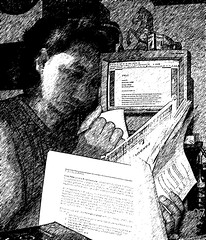
Studious rolly
Originally uploaded by rollycaidic
FMA 2
Honestly, the first time I tried to read Module 1 I felt bored. I thought chemical formulas plus biology is not a good recipe. Then I browsed through the pages, it shocked me seeing more and more tongue twisting scientific terminologies that even my brain could knot remembering it all. Well, this could be the dilemma of a non-major-student-majoring-biology. I told my self that its ok since I am not yet actually ‘fully-cooked’ in this field, and it is a must that I undergone this as the first part of the course.
It was enlightening for me to read the Reader Volumes provided by our professor. It made me felt the gravity of being ‘majors’ compared non-majors. I realized that it was a big deal for me as a DST Major in Biology to understand the very-most-lowest level or unit of all living organisms and the very thought of understanding the origins of life.
I agree with the article of Prof. Hidalgo, we, teachers should not rely on the recipe-type science experiments. These activities would not deliver science literacy and it would not strengthen student’s science skills in employing scientific method since we already expect the answers or the actual result. It’s a reality that teachers, personally speaking, do sometimes avoid questions that are not expected to come up and are hard or difficult to answer. That’s why I always resort to making guide questions which I know the answers and have restrictions. But knowing the three-folds of science education made me feel guilty. Funny, looking back to my past teaching escapades when I make a lot of shortcomings and realizing never to make those mistakes again.
Points of View: Content versus Process is also revealing to me. I think ‘processes’ should have more emphasis over ‘contents’. Although both of them are very essential in scientific literacy especially for my high school students I think ‘content’ are readily available around us. You surf the internet, visit a library, read science journals and other publications… contents are all you could get. But process is one thing that anyone could not dig up that easily. It takes a lot of time, effort and hard work to perform like laboratory activities. On the other hand let us also give emphasis on the ‘skills’ part. On my opinion, it is not a matter of who wins between ‘content’ or ‘process’ or ‘skill’. Let us not forget that those three are all essential in science education. This is the holistic nature of science. The thee-fold of science education is inseparable.
Analyzing the three-fold objectives of teaching science made me come up with this conceptual framework:
I compare Bloom’s Taxonomy also known as Taxonomy of Educational Objectives and it also falls under the three-fold of teaching science. I think the very aim of science literacy is also the same with all other subjects. But scientifically speaking, cognitive domain must be focus on knowledge content about science. Psychomotor domain in science is about performing and demonstrating laboratory activities, then affective domain in science emphasizes on the interests, attitudes and appreciation towards scientific method.
Perfect Timing!
The topic on Cellular and Molecular Basis of Life is just in time with my daily schedule of topics and the learning competencies I am following. It is related to the topic that I am going to teach this week. Actually, last school year after I discussed the cellular basis of life I jump to the topic on cellular respiration. Now I realized that it is also very important for my students to know the molecular and chemical basis of life. I remember my student asked me the question “Are humans and all other living organisms also made up of atoms?” Now is the right time for me to deeper their knowledge on atoms and chemicals.
I also like the clear explanations on the topic of Other Theories on the Origin of Life. The statement on special creation is well justified. With my past experience, my class usually has a debate between science and religion and I rather not talk about it before. My students would normally asks “Sir bakit po sa Bible iba ang sinasabi?” But now it’s clearer to me.
I compare our school’s textbook Functional Biology by Rabago and the Biology by Rivero and Cao on the topic on Origin of Life. I found the illustration on Figure 1-1 Synthesis reactions leading to biological evolution very understandable. For my students, seeing illustrative or conceptual representation is easier than reading all-text topics which are not on the book by Rabago. The video is also very fun and educational as well. If Prof. Hidalgo would allow me to use it for film showing to my class that would also be more exiting for my students!
On the other hand, the Manifestations and Characteristics of Life are very technical or strictly interpreted compared to the BIO A Principles of Biology by Barrion and Zafarrala which is categorized into different sections or topics. I think it would be hard to explain to my students the way the content is presented. Content-wise I choose BIO A book on this specific topic because it is the same with our textbooks in school and my other references in school.
I also like the tabular format on the Biology A Study Guide because it is easier to understand the same with my other reference books. I have a weak point on stuff about chemicals and its processes that’s why I would like to know more about the cellular respiration. I find it hard analyzing compounds and I suck explaining them. I hope I could learn more about it so that I can clearly discuss it to my students.

